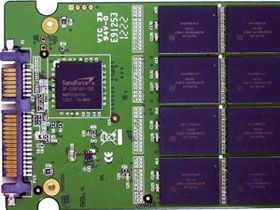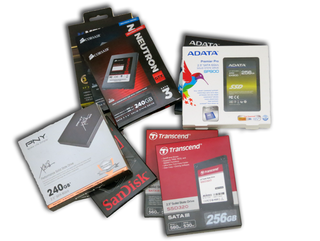Time To Upgrade: 10 SSDs Between 240 And 256 GB, Rounded Up

10 SSDs Between 240 And 256 GB
When Thomas, Don, and Paul prioritize the parts for their quarterly System Builder Marathon configurations (the next of which is coming soon, by the way), they pick the components most likely to bolster the performance of their machines in a benchmark. Graphics cards get lots of attention, as do CPUs. Now, I don't want to speak out on behalf of our chosen three, but it appears as though storage is the third-highest consideration nowadays, ahead of memory or motherboards. Specifically, our guys try, where possible, to get at least a small SSD in their builds alongside a larger conventional disk.
Building a tiered storage subsystem is something we've been advocating for a while now. Realistically, you're not going to buy enough flash-based storage to replace magnetic media. And you don't want to load up on disks at the expense of performance, right? So, mix 'em up. The video below should be justification enough.
Now, it used to be that we'd pick up 40 and 60 GB SSDs, paying $100 or so for them, just to get some sort of solid-state storage into our desktops. Those things barely had enough room for Windows 7 and a couple of apps, though. Today, you can almost get 128 GB for the same price. And while we like the idea of triple-digit capacity, even 128 GB feels cramped pretty quickly. So, with the cost per gigabyte of SSD-based storage down huge from last year, 240/256 GB is where we're pinning our ambitions for mid-range machines in 2013.
We keep up with the launches of new storage products, particularly when they involve the introduction of fresh controller technology, a NAND process shrink, or even a significant firmware update. But, even after we do our round-ups, drives continue surfacing.

As a result, today we have 10 SSDs in the 240 to 256 GB range. Some are based on familiar technology (mainly, SandForce's second-gen controller), while others employ controllers we've never tested before (Corsair's Neutron family). In the middle, we have a handful of drives based on common hardware, but set up in a new way (SandForce-based drives with no over-provisioning).
Can we promise you shocking test results that completely turn your world upside-down? No. When it comes to performance, the best of the best is pretty darned close to second-best these days. But we are seeing price tags on some of these SSDs that really impress us. Five of the 10 models we're looking at sell for less than $200. And all but one of them go for less than $1 per gigabyte. Do you think you might be able to fit a nice big SSD into your budget for 2013? If prices continue on the trajectory they're on, we don't see why not!
Stay on the Cutting Edge
Join the experts who read Tom's Hardware for the inside track on enthusiast PC tech news — and have for over 25 years. We'll send breaking news and in-depth reviews of CPUs, GPUs, AI, maker hardware and more straight to your inbox.
Current page: 10 SSDs Between 240 And 256 GB
Next Page Adata XPG SX900 And Premiere Pro SP900-
mayankleoboy1 get the cheapest, biggest you possibly can. Benchmarks exaggerate the difference between SSD's.Reply -
A Bad Day I agree. Unless if you're buying a glorified USB stick (there is a 128 GB stick) or an SSD with an OC'ed processor, the main factor that consumers should be concerned about is price per gigabyte.Reply -
A Bad Day EDIT: And reliability.Reply
"In order to install a new firmware that significantly boost performance and stability, you must backup all of your data because it will be wiped." -
Tanquen Yea, it’s getting a little out of hand. For 90% of the things 90% of people do on their PC, 200MBs+ read and write speeds just don’t mean much. There are too many other bottle necks going on. I messed around with a RAM drive using most of my 64GB of RAM and the read and write speeds are fun to test (4000MBs or so) but games and VMware sessions I launched from the RAM disc saw no noticeable improvement in launch times or anything else. Same goes for my 830 SSD drive. It’s fast but games and software I use for SCADA development just don’t see any real benefit. They are cool if you want to open 10 sessions of MS Word and 15 Internet Explorer and a bunch of other stuff at the same time but if you just open one instance of Excel and use it and the Photo Shop and use it and then a web browser and use it, you’ll never really see the difference. You have to benchmark it or have two PCs setting right next to each other to see that something started or saved a split second faster.Reply
At least with my 64GB of RAM and actually get 64GB of RAM unlike HDs and SSDs.
-
tomfreak unless the sandforce drive is priced a lot cheaper than the similar capacity non-sandforce SDD. I always choose the non-sandforce SSD. 16GB is a big deal in SSD.Reply -
stoogie until theres affordable 512gb ssd's then i wont get 1, my c drive is 360gb~ and i have 11tbReply -
sna TanquenYea, it’s getting a little out of hand. For 90% of the things 90% of people do on their PC, 200MBs+ read and write speeds just don’t mean much. There are too many other bottle necks going on. I messed around with a RAM drive using most of my 64GB of RAM and the read and write speeds are fun to test (4000MBs or so) but games and VMware sessions I launched from the RAM disc saw no noticeable improvement in launch times or anything else. Same goes for my 830 SSD drive. It’s fast but games and software I use for SCADA development just don’t see any real benefit. They are cool if you want to open 10 sessions of MS Word and 15 Internet Explorer and a bunch of other stuff at the same time but if you just open one instance of Excel and use it and the Photo Shop and use it and then a web browser and use it, you’ll never really see the difference. You have to benchmark it or have two PCs setting right next to each other to see that something started or saved a split second faster.At least with my 64GB of RAM and actually get 64GB of RAM unlike HDs and SSDs.Reply
to see the difference you will need to put the system itself on RAM Disk. not only the installed programs.
-
Where are Samsung SSDs ? Especialy model Samsung 830- 256GB which is on sale in Europe for 160-180€. That is best offer, reliable, faster than basic 840. Get some MB with Z77 chipset and you can RAID them with TRIM support. 2x256 for 330€ is so awesome with 1035Mb/s read in RAID 0. I tested it on Gigabyte Z77-UP4 TH, its a shame that there are only 2x6Gbit ports so 1x840 Pro + 2x830 in RAID 0 is impossible on this MB without SATA2 speed loss on remaining SATA ports. This was my scenario for fast gaming /500GB Steam inventory/ : Raptor, later RAID 0 HDDs, later Velociraptor, next 128GB SSD + 1GB Samsung HDD cached by OCZ Synapse 64GB /totaly unreliable/. So I ended up with 1x boot SSD + 2x SSD in RAID 0. Maybe I am little bit offtopic but any ideas how to "live" with increased Steam inventory and keep it fast enough ? Steamover SW is not reliable for me. Thanks for nice article.Reply
-
ojas ReplyWhen Thomas, Don, and Paul prioritize the parts for their quarterly System Builder Marathon configurations (the next of which is coming soon, by the way)
Wait, SBMs are fine, but where oh where went BestConfigs? -
-Fran- I went for a Vertex4 and placed it in my notebook. What a boost. I'd say it also helped improve battery life.Reply
For a Desktop, I don't have a particular use TBH. I have a RAID0 with 2x512GB WD's and it works amazingly good (and fast as well). I'd say, for desktops, SSDs are still not viable because of price, unless you clench your teeth with loading times or such, hahaha.
Cheers!
Most Popular

